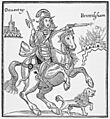Prince Rupert of the Rhine facts for kids
Quick facts for kids Prince Rupert |
|
|---|---|
| Count Palatine of the Rhine Duke of Cumberland Earl of Holderness |
|

Portrait by Peter Lely
|
|
| Born | 17 December 1619 (O.S.) Prague, Bohemia |
| Died | 29 November 1682 (aged 62) (O.S.) London, England |
| Burial | 6 December 1682 (O.S.) Westminster Abbey |
| Issue | Dudley Bard (1666–1686) Ruperta Howe (1671–1740) |
| House | Palatinate-Simmern |
| Father | Frederick V, Elector Palatine |
| Mother | Elizabeth Stuart |
| Religion | Calvinist |
| Occupation | Soldier, statesman, privateer, and scientist |
Prince Rupert of the Rhine (born December 17, 1619 – died November 29, 1682) was a German-English soldier, admiral, scientist, and colonial governor. He was a very important figure in 17th-century England.
Rupert first became famous as a leader of the Royalist cavalry during the English Civil War. He was the third son of Frederick V of the Palatinate and Elizabeth of Bohemia, who was the daughter of King James VI and I of Scotland and England.
Prince Rupert had a very exciting and varied life. As a child, he was already a soldier, fighting in Europe. When he was 23, he became a top commander for the Royalist army in the English Civil War. He was known as a "Cavalier." After the war, he was sent away from England.
He then worked for the King of France and later became a privateer, which is like a legal pirate, in the Caribbean Sea. After the English monarchy was restored, Rupert came back to England. He became a senior naval commander in wars against the Dutch. He also helped start the Hudson's Bay Company, which was a big trading company. Prince Rupert died in England in 1682 when he was 62.
Rupert was known as a fast-thinking and energetic cavalry general. He made important contributions to the Royal Navy's strategies and growth. As a colonial governor, he helped shape the map of modern Canada. A large area called Rupert's Land was named after him. He was also interested in science and art, making him a very interesting public figure.
Contents
Family Background
Rupert's father was Frederick V of the Palatinate. His family, the House of Palatinate-Simmern, was part of the important House of Wittelsbach in Germany. Frederick was one of the most powerful princes in the Holy Roman Empire. He was also the leader of the Protestant Union, a group of German states that followed the Protestant faith.
Rupert's mother was Elizabeth Stuart, who was the daughter of King James VI and I of Scotland and England. This meant Rupert was the nephew of King Charles I of England and the first cousin of King Charles II of England. King Charles II later made Rupert the Duke of Cumberland and Earl of Holderness. Rupert's sister, Sophia of Hanover, was the mother of George I of Great Britain, who later became King of Great Britain.
Rupert was named after Rupert, King of Germany, a famous ancestor from his father's family.
Early Life and Time in Exile

Rupert was born in Prague, Bohemia, in 1619. His father had just been chosen as king by the people of Bohemia, who were mostly Protestant. This made the Catholic House of Habsburg very angry, and it started the Thirty Years' War.
Rupert's parents had to quickly escape Prague. They were called the "Winter King and Queen" because their rule lasted only one winter. Rupert almost got left behind in the rush!
Rupert grew up in The Hague in the Netherlands. His parents were not very involved in their children's lives. Instead, a French couple taught Rupert and his siblings. They learned subjects like logic, math, writing, and drawing. Rupert was sometimes a bit wild and earned the nickname Robert le Diable, or "Rupert The Devil."
Despite this, Rupert was a good student. By age three, he could speak English, Czech, and French. He was very good at art, math, and science. By the time he was 18, he was about 6 feet 4 inches tall.
His family struggled financially while in exile. They tried to get support from other countries to regain their lands. In 1632, Rupert's father died of a fever. Rupert was only 13. This was a big loss for the family.
Teenage Years and Early Military Career

Rupert spent his teenage years between The Hague and the court of his uncle, King Charles I of England. He became a soldier very early. At 14, he was already fighting alongside Dutch forces. By 1635, he was a bodyguard for Prince Frederick.
He fought against Spain in the Netherlands during the Eighty Years' War. By the end of this time, Rupert was known for being fearless in battle and very energetic.
In 1637, Rupert commanded a cavalry regiment to help his brother, Charles Louis, try to get their lands back. This campaign ended badly at the Battle of Vlotho in 1638. Rupert was captured by enemy forces.
He was imprisoned in Linz. His mother was worried he might be forced to change his religion from Calvinism to Catholicism. The Emperor even offered him freedom and a position as a general if he converted, but Rupert refused.
Rupert's imprisonment became easier over time. He practiced etching, played tennis, and went on hunting trips. He also received a white poodle named Boy, who stayed with him for many years. Rupert was finally released in 1641 after promising not to fight against the Emperor again. He then left Germany for England.
Role in the English Civil War
Rupert is most famous for being a Royalist commander during the English Civil War. He had great success early on because of his energy and knowledge of European fighting methods. However, as the war continued, his youth and difficulty getting along with other commanders caused problems.
Rupert was a powerful symbol for the Royalists. He was often shown in propaganda by both sides.
Early Battles, 1642–1643
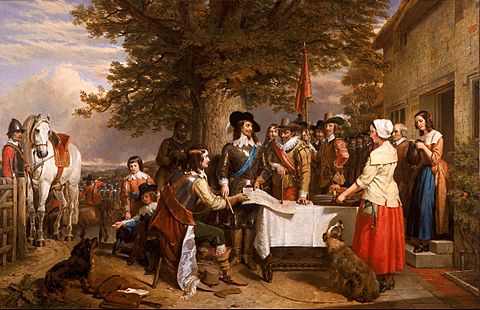
Rupert arrived in England in 1642. He joined King Charles I's small army and was quickly made General of Horse, meaning he commanded the cavalry. He worked hard to train his forces.
Rupert quickly showed his skill. He led a sudden charge that defeated a Parliamentarian force at Powick Bridge. This was the first battle of the war and made Rupert a hero for many Royalists.
He played a key role in the Battle of Edgehill in October. Rupert's men made a dramatic cavalry charge. However, his troops scattered, turning a possible victory into a draw.
After Edgehill, Rupert wanted to attack London quickly. But the King's advisors wanted to move slowly. By the time they arrived, London was ready to defend itself. Some people think this delay cost the Royalists their best chance to win the war.
In 1643, Rupert cleared the South-West, taking Cirencester and the important port of Bristol. He was made governor of Bristol. By mid-1643, Rupert was so well known that Parliament wanted him punished as part of any peace deal.
Later Battles, 1644–1646
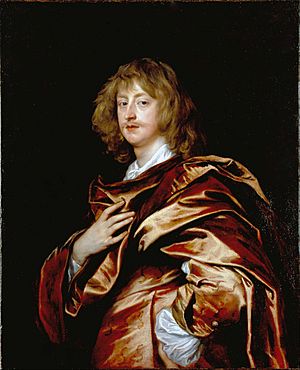
As the war continued, some Royalist leaders began to oppose Prince Rupert. He was known for being frank and brave, but also for having a quick temper. He was too quick to show who he liked and disliked. This meant he made many enemies at court, especially with George Digby, a favorite of the King.
Rupert continued to be a strong military leader. By 1644, he was the Duke of Cumberland and Earl of Holderness. He led forces to help Newark-on-Trent and York. He took Bolton and Liverpool in bloody attacks.
He commanded much of the Royalist army at the Battle of Marston Moor, where they were defeated. Many blamed the poor teamwork between Rupert and the Marquess of Newcastle.
In November 1644, Rupert became general of the entire Royalist army. This made tensions with the King's advisors even worse. In May 1645, Rupert captured Leicester. But a month later, he suffered a major defeat at the Battle of Naseby. Rupert had advised against fighting at Naseby, but Digby's advice won. Still, Rupert was blamed politically.
After Naseby, Rupert believed the Royalist cause was lost and urged King Charles to make peace. Charles, however, still thought he could win. In September 1645, Rupert was trapped in Bristol by Parliament's forces. He had to surrender Bristol. King Charles then removed him from his command.
Rupert traveled to the King at Newark-on-Trent to clear his name. He convinced the King to hold a court-martial, which found him innocent. After another argument, Rupert resigned and left the King's service. He knew the war was lost. Rupert and his brother left England in 1646 after the surrender of Oxford.
Public Image and Propaganda
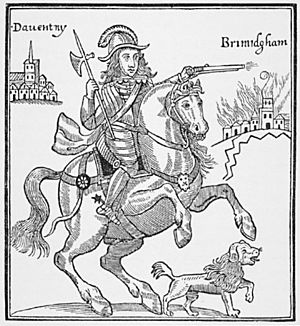
Rupert was often accused of being brutal during the war, though later historians have largely cleared his name. He grew up with the harsh customs of the Thirty Years' War in Europe. When he came to England, he sometimes used similar tactics, like demanding money from towns to avoid sacking them. This was not common in England and the King told him off.
Rupert's reputation suffered. He was accused of burning Birmingham (which was probably untrue). He also threatened to kill all soldiers in Lichfield after they executed Royalist prisoners.
He was a popular target in Parliamentarian propaganda. People accused him of witchcraft, often through his pet dog, Boy. Boy was a large white hunting poodle who went everywhere with Rupert. Many believed Boy was a witch's helper or even the Devil. Stories claimed Boy could find treasure, was bulletproof, could catch bullets, and could predict the future. Similar stories were told about Rupert's pet monkey.
Life After the Civil War
After the First English Civil War, Rupert worked for King Louis XIV of France fighting the Spanish. His work was complicated by his promise to the Holy Roman Emperor not to fight him. He also became a Knight of the Garter. Rupert often struggled with money and argued with other Royalists in exile.
Serving in the French Army
Rupert first went to the Royal court in exile in France. But it was still controlled by the Queen and Rupert's enemy, Digby. So, Rupert took a well-paid job with the French army.
In 1647, Rupert fought against the Spanish. He took the strong fortress of La Bassée through clever talks, which was impressive. He was seriously injured in a Spanish ambush shortly after.
In 1648, the Second English Civil War began. Rupert told the French King he was returning to King Charles's service. The Parliamentarian navy rebelled and joined the King, giving the Royalists a large fleet. Rupert joined the fleet.
Rupert argued that the fleet should rescue the King. But the fleet quickly lost discipline. Rupert had to personally intervene several times, even dangling a mutinous sailor over the side of his ship! Most of the fleet eventually went back to England.
Rupert then took command of the Royalist fleet. His plan was to use the ships to attack English merchant vessels and make money for the Royalists. However, the Parliamentarian fleet was growing stronger, led by the skilled Admiral Robert Blake.
Rupert's naval campaign had two parts. First, he sailed from Ireland to Lisbon, Portugal, capturing ships along the way. King John IV of Portugal welcomed him. Blake arrived with a Parliamentarian fleet, leading to a tense standoff. Rupert's fleet eventually broke out and sailed into the Mediterranean Sea.
The second part of the campaign involved sailing to the Azores and then to the Caribbean. A bad storm sank one of his main ships, the Constant Reformation, and nearly killed his brother, Maurice of the Palatinate. Another hurricane in the Caribbean sank the Defiance, with Prince Maurice on board. Maurice's death was a terrible blow to Rupert.
Rupert returned to France in 1653. The piracy campaign had not made as much money as hoped. Rupert, tired and a bit sad, returned to France.
In 1654, Rupert might have been involved in a plot to kill Oliver Cromwell. But King Charles II supposedly rejected the idea. Rupert's presence at court was still seen as a problem for peace talks. In 1655, Rupert left for Germany.
Time in Germany
Rupert visited his brother Charles I Louis, Elector Palatine in Heidelberg. Their reunion was difficult. Charles Louis had lost half his lands and was short on money.
Rupert then went to Vienna to try and get money he was owed. The Emperor welcomed him but could not pay him right away. Rupert also tried to convince the Emperor to help Charles II regain his throne.
In 1656, Rupert's relationship with his brother got worse. Rupert had fallen for one of his sister-in-law's maids of honor. This led to problems and the annulment of his brother's marriage. Rupert was also unhappy that his brother could not give him a suitable estate. They parted ways in 1657, and Rupert refused to return to the Palatinate. He then worked for the Emperor in Hungary.
Interest in Art
During this time, Rupert became very involved in developing a new printing technique called mezzotint. This method allowed artists to create prints with smooth shades and tones. Rupert claimed he got the idea from watching a soldier scrape rust from a musket barrel.
While some credit the invention to another German artist, Rupert became a skilled mezzotint artist himself. He made some beautiful prints and brought the technique to England. His most famous artwork, The Great Executioner (1658), is still considered a masterpiece.
Life After the Monarchy Was Restored

When King Charles II of England returned to the throne in 1660, Rupert came back to England. Most top government jobs were already taken, but Charles gave Rupert a large pension of £4,000 a year. Rupert's close family ties to the King were very important. He was the King's closest adult relative after his brother.
Rupert became a member of the House of Lords. He was more mature now. People said his temper was less explosive and his judgment was better. He continued to serve as an admiral in the Royal Navy, eventually becoming "General at Sea and Land."
Statesman Role
In 1662, Rupert joined the King's Privy Council of England. He worked on committees for foreign affairs, the navy, and Tangier. Some records show he was very active in these meetings.
In 1668, the King made Rupert the Constable of Windsor Castle. Rupert was already a Knight of the Garter, and the castle was their headquarters. Rupert immediately began improving the castle's defenses and grounds. He had his own unique apartments there, decorated with many weapons and interesting pictures. King Charles II and Rupert spent a lot of time together at Windsor, hunting and playing tennis.
Rupert became involved with Frances Bard (1646–1708). Frances claimed they secretly married, but Rupert denied it. However, he did acknowledge their son, Dudley Bard (1666–86), who was often called "Dudley Rupert." In 1673, Rupert's brother urged him to marry and have an heir for their family lands, but Rupert refused and stayed in England.
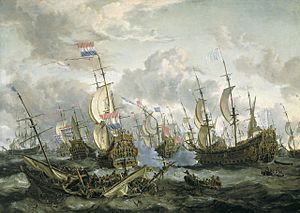
England was often at war with the Netherlands over trade during the 17th century. Rupert became a senior admiral for King Charles II, eventually commanding the Royal Navy. He was unusual because he had experience leading both large land armies and naval fleets.
At the start of the Second Anglo-Dutch War (1665–67), Rupert was a squadron commander. He fought at the Battle of Lowestoft in 1665, where he was injured in the leg. The next year, Rupert was made joint commander of the fleet. In June 1666, they fought the Dutch in the Four Days' Battle, one of the longest naval battles ever. Rupert and his co-commander used new aggressive tactics. The Dutch won this battle, but Rupert and his partner used the same tactics to win the St. James's Day Battle the next month.
Rupert also played a big role in the Third Anglo-Dutch War (1672–74). He had designed a new, powerful naval gun called the Rupertinoe. However, it was very expensive, so it wasn't used widely. Rupert was made supreme Allied commander in 1673. He fought the Dutch in the Battle of Schooneveld and the Battle of Texel. These battles were controversial, with some blaming the French allies for not fully engaging. Rupert was seen as a hero by many English people. He retired from active sea command later that year.
Rupert had a unique style as an admiral. He was known for his energetic leadership and close contact with his officers. He also helped improve how orders were given to the British fleet, which was very important for naval strategy for the next hundred years.
After 1673, Rupert remained a senior member of the Royal Navy. He focused on improving how the navy was run, including manning ships and selecting officers. He was also appointed "General at Sea and Land," giving him wartime powers over the navy.
Later Life and Interests
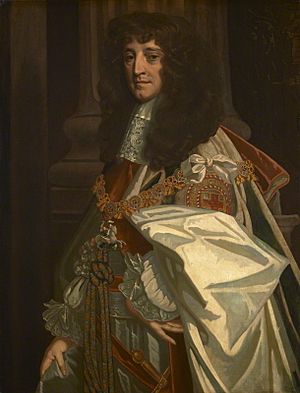
After his naval career, Rupert spent more time on government work and scientific research. He was seen as a bit old-fashioned by younger people at court. His health was also not as good. He had a painful head wound and his leg still hurt. He also suffered from malaria he caught in Africa.
Colonial Work
Rupert had been interested in colonies for many years. In 1660, he encouraged an expedition to the Gambia in Africa to find gold. He became a shareholder in the Company of Royal Adventurers Trading into Africa, which was involved in the West Africa slave trade.
However, Rupert's main focus turned to North America. Two French explorers told him about the Hudson's Bay region in Canada. Rupert invested his own money and raised more for an expedition. In 1669, one of the ships, the Nonsuch, returned with valuable furs.
In 1670, King Charles approved the charter for the Hudson's Bay Company. This company was given a trading monopoly over a huge area of Canada, which was named Rupert's Land in his honor. Rupert was made the first Governor of the company. The Hudson's Bay Company became very successful and was important for Canada's colonial trade.
Science and the Royal Society
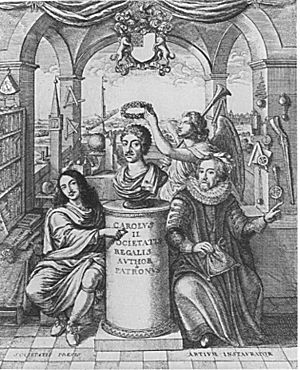
After retiring from active sea duty around 1674, Rupert spent more time on science. He was credited with many inventions and discoveries. He even turned some rooms at Windsor Castle into a fancy laboratory.
Rupert was a founding member of the Royal Society, a group of scientists. He showed them Prince Rupert's Drops, which are glass teardrops that explode when their tail is cracked. He also showed a new device for lifting water and a way to paint on marble.
Many of Rupert's inventions were military. He designed the Rupertinoe naval gun. He also invented a gun that fired multiple rounds quickly and a "handgun with rotating barrels." He developed a powerful type of gunpowder and a torpedo. He also created a form of grapeshot for artillery.
Rupert also worked on naval inventions, like a balancing tool for measurements at sea and a diving engine to retrieve objects from the ocean floor. He even invented new surgical tools while recovering from his own head surgery.
His scientific work also included metallurgy. Rupert invented a new brass alloy, slightly darker than regular brass, which became known as "Prince's metal" in his honor. He also found a better way to make shot of different sizes.
Personal Life and Family
Towards the end of his life, Rupert fell in love with a famous actress named Peg Hughes. Rupert became involved with her in the late 1660s. Hughes quickly gained status and was painted by the famous court artist, Sir Peter Lely.
Rupert did not marry Hughes, but he acknowledged their daughter, Ruperta, who was born in 1673. Hughes lived an expensive life, and Rupert gave her a lot of valuable jewelry. Rupert bought a large house in Hammersmith for Hughes. He seemed to enjoy family life, saying his young daughter "already rules the whole house."
Death and Legacy
Rupert died at his home in London on November 29, 1682, after an illness. He was buried in Westminster Abbey on December 6 in a state funeral. He left most of his money to Hughes and Ruperta.
Hughes had a difficult time after Rupert's death, partly because of her gambling. She sold many of the valuable gifts Rupert had given her.
Ruperta later married Emanuel Scrope Howe and had five children. Rupert's son, Dudley Bard, became a military officer and died fighting in Hungary when he was a teenager.
Prince Rupert is remembered as a brave warrior who was sometimes difficult to work with. He was admired for his daring actions in battle, both on land and at sea.
His memory is especially strong in Canada. The lands of the Hudson's Bay Company, which drain into Hudson Bay, were known as Rupert's Land for 200 years. The Anglican Diocese of Rupert's Land still exists today. Many places in Canada are named after him, including the city of Prince Rupert, British Columbia, and the Rupert River in Quebec.
In Bristol, England, there is a street called Rupert Street, named to remember him.
Genealogical table
| Rupert's relationship with the House of Stuart (selective chart) | |||||||||||||||||||||||||||||||||||||||||||||||||||||||||||||||||||||||||||||||||||||||||||||||||||||||||||||||||||||||||||||||||||||||||||||||||||||||||||||||||||||||||||||||||||||||||||||||||||||||||||||||||||||||||||||||||||||||||||||||||||||||||||||||||||||||||||||||||||||||||||||||||||||||||||||||||||||||||||||||||||||||||||||||||||||||||||||||||||||||||||||||||||||||||||||||||||||||||||||||||||||||||||||||||||||||||||||||||||||||||||||||||||||||||||||||||||||||||||||||||||||||||||||||||||||||||||||||||||||||||||||||||||||||||||||||||||||||||||||||||||||
|---|---|---|---|---|---|---|---|---|---|---|---|---|---|---|---|---|---|---|---|---|---|---|---|---|---|---|---|---|---|---|---|---|---|---|---|---|---|---|---|---|---|---|---|---|---|---|---|---|---|---|---|---|---|---|---|---|---|---|---|---|---|---|---|---|---|---|---|---|---|---|---|---|---|---|---|---|---|---|---|---|---|---|---|---|---|---|---|---|---|---|---|---|---|---|---|---|---|---|---|---|---|---|---|---|---|---|---|---|---|---|---|---|---|---|---|---|---|---|---|---|---|---|---|---|---|---|---|---|---|---|---|---|---|---|---|---|---|---|---|---|---|---|---|---|---|---|---|---|---|---|---|---|---|---|---|---|---|---|---|---|---|---|---|---|---|---|---|---|---|---|---|---|---|---|---|---|---|---|---|---|---|---|---|---|---|---|---|---|---|---|---|---|---|---|---|---|---|---|---|---|---|---|---|---|---|---|---|---|---|---|---|---|---|---|---|---|---|---|---|---|---|---|---|---|---|---|---|---|---|---|---|---|---|---|---|---|---|---|---|---|---|---|---|---|---|---|---|---|---|---|---|---|---|---|---|---|---|---|---|---|---|---|---|---|---|---|---|---|---|---|---|---|---|---|---|---|---|---|---|---|---|---|---|---|---|---|---|---|---|---|---|---|---|---|---|---|---|---|---|---|---|---|---|---|---|---|---|---|---|---|---|---|---|---|---|---|---|---|---|---|---|---|---|---|---|---|---|---|---|---|---|---|---|---|---|---|---|---|---|---|---|---|---|---|---|---|---|---|---|---|---|---|---|---|---|---|---|---|---|---|---|---|---|---|---|---|---|---|---|---|---|---|---|---|---|---|---|---|---|---|---|---|---|---|---|---|---|---|---|---|---|---|---|---|---|---|---|---|---|---|---|---|---|---|---|---|---|---|---|---|---|---|---|---|---|---|---|---|---|---|---|---|---|---|---|---|---|---|---|---|---|---|---|---|---|---|---|---|---|---|---|---|---|---|---|---|---|---|---|---|---|---|---|---|---|---|---|---|---|---|---|---|---|---|---|---|---|---|---|---|---|---|---|---|---|---|---|---|---|---|---|---|---|---|---|---|---|---|---|---|---|---|---|---|---|---|---|---|---|---|---|---|---|---|---|---|---|---|---|---|---|---|---|---|---|---|---|---|---|---|---|---|---|---|---|---|---|---|---|---|---|---|---|---|---|---|---|---|---|---|---|---|---|---|---|---|---|---|---|---|---|---|---|---|---|---|---|---|---|---|---|---|---|---|---|
|
|||||||||||||||||||||||||||||||||||||||||||||||||||||||||||||||||||||||||||||||||||||||||||||||||||||||||||||||||||||||||||||||||||||||||||||||||||||||||||||||||||||||||||||||||||||||||||||||||||||||||||||||||||||||||||||||||||||||||||||||||||||||||||||||||||||||||||||||||||||||||||||||||||||||||||||||||||||||||||||||||||||||||||||||||||||||||||||||||||||||||||||||||||||||||||||||||||||||||||||||||||||||||||||||||||||||||||||||||||||||||||||||||||||||||||||||||||||||||||||||||||||||||||||||||||||||||||||||||||||||||||||||||||||||||||||||||||||||||||||||||||||
In Fiction
- Prince Rupert is the main character in Poul Anderson's fantasy book A Midsummer Tempest. In this story, he wins the English Civil War with the help of characters from Shakespeare's plays.
- Prince Rupert is a key character in the King Crimson song Lizard from their 1970 album. Parts of the song are named Prince Rupert Awakes and The Battle of Glass Tears.
- Prince Rupert appears in The Oak Apple and The Black Pearl, historical novels by Cynthia Harrod-Eagles. He is helped by the fictional Morland family during the Civil War.
- Prince Rupert is the main character in Margaret Irwin's novel The Stranger Prince.
- Prince Rupert's Tower is a historic building in Liverpool. Rupert stayed in the area during the siege of Liverpool.
Film and Television
- Timothy Dalton played Rupert in the 1970 film Cromwell.
- Will Bowden played Rupert in the 2015 Dutch film Michiel de Ruyter.
Images for kids
-
Portrait by Peter Lely
-
King Charles I (in blue sash) holding a meeting before the Battle of Edgehill. Rupert, seated, led the King's cavalry.
-
George Digby, 2nd Earl of Bristol, by Sir Anthony Van Dyck. Digby was a political rival to Rupert.
-
Rupert was often shown in Parliamentarian propaganda, like this image with his dog Boy, supposedly pillaging Birmingham.
-
Rupert at the start of the Interregnum, after William Dobson.
-
Frances Bard, Rupert's mistress, painted by Peter Lely.
-
The Four Days' Battle, June 1–4, 1666, by Abraham Storck. Rupert's new aggressive tactics were used here.
-
The Battle of Texel, by Willem van de Velde the Younger. This Dutch victory marked the end of Rupert's career as a sea admiral.
-
An older Rupert, painted in 1670 by Sir Peter Lely.
-
Rupert was a founding member of the Royal Society. This 1667 engraving shows its wide interests in science and technology.
See also
 In Spanish: Ruperto del Rin para niños
In Spanish: Ruperto del Rin para niños





